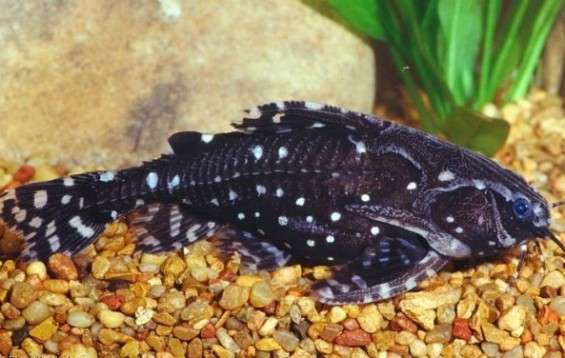
Size
Adults normally range in size from 4.75 to 5.9 inches (12 – 15 cm).
Physical Characteristics and Behavior
A Spotted Raphael Catfish has a body that is elongated and narrow, much like an arrow. Compared to men, women typically have broader proportions. They can reach a maximum length of 15 cm (5.9 inches). Although aficionados have observed them living up to 15-20 years, their normal lifespan is thought to be ten years. This type of catfish has small eyes while having an enormous head. The mouth is large, and there are three sets of barbels—one on the upper jaw, two on the lower. Like other members of their genus, they have thick skin and a well-developed nuchal shield in front of the dorsal fin. From bony lumps, rough scutes spread laterally.
Keeping in Captivity

- Tank Setup and Habitat Needs
While spotted catfish may hide throughout the day, after the lights go out, they become highly active. The following criteria are essential for keeping a healthy population of catfish in your aquarium:
- The Aquarium Size
Despite their small size, these catfish require a lot of space to hide and forage for food. However, because a single catfish needs at least a 35-gallon tank, they are not appropriate for nano tanks. A 55 to 75 gallon tank is required if you want to keep a school of 3 to 5 catfish.
- Water Conditions
The fish lives in waters that are abundant in Temperature: 72° – 79° F (22° – 26° C) pH: 5.5 – 7.5. KH: 2 – 20 dKH. A 55-gallon tank is the basic minimum for a small group.
- Plants, Substrate, and Decorations
To avoid your catfish getting hurt by sharp pebbles, it is advisable to use soft aquatic sand, dirt, or fine gravel as the tank’s substrate. Give your catfish a lot of big boulders, driftwood, and branches so they have places to hide throughout the day. Juveniles can also find safety in dense clusters of living plants because the adults won’t harm or eat them.
- Lighting, Aeration, and Filtration
Spotted catfish enjoy water that is minimally flowing, thoroughly filtered, and oxygenated. To stop powerful currents from flowing through the bottom portions of your tank, you might need to baffle your filter. For maintaining high oxygen levels, an air stone and pump are helpful. They prefer tanks with decorations or floating plants to provide shade as they dislike strong lights. A blue LED or moonlight are the ideal nighttime viewing options for catfish.
- Feeding
Talking As scavengers, spotted catfish will assist keep your tank free of food scraps because they are omnivores and don’t have a particular food preference. It’s ideal to feed them once a day around twilight in order to prevent overfeeding and obesity-related issues. To train them to emerge for food, throw some sinking catfish or spirulina pellets near their hiding place. Several times a week, you can also give them treats like brine shrimp, bloodworms, crustacean, or insect eggs.
- Interactions between Tank Mates
Catfish can be kept in a single species tank, but because of their calm disposition, they are a great choice for medium to large community aquariums. Keep your catfish away from fish, shrimp, or snails that are small enough to serve as snacks. Think of keeping medium to large fish like Central and South American cichlids in an aquarium with an Amazon theme.
- Tetras
- Gouramis
- Central and South American cichlids
- Other friendly catfish like the Pictus Cat
Table





